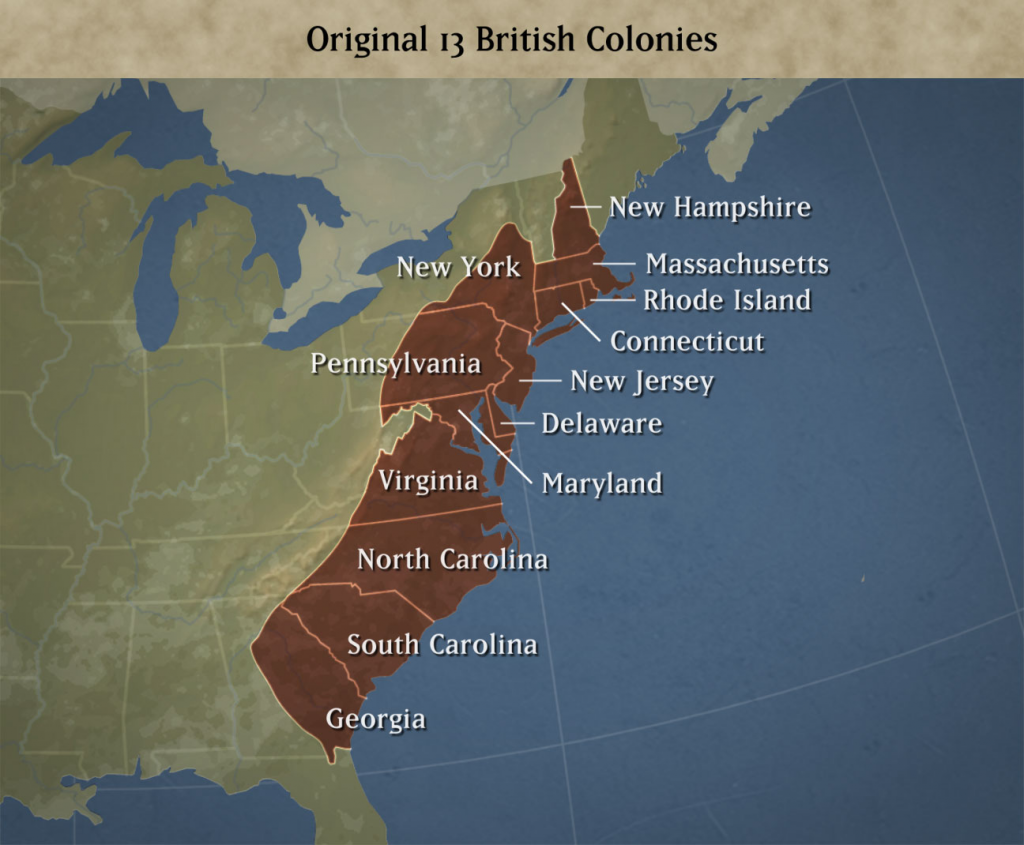The story of America’s thirteen colonies is a tale of diversity, ambition, and the seeds of revolution. From the fiery independence of New England to the genteel plantations of the South, each colony carved out its unique identity. Yet, beneath the surface of this patchwork of cultures and economies lay the tensions that would eventually spark the birth of a new nation.

The New England Colonies: A Hotbed of Rebellion
New England, with its rocky soil and harsh winters, bred a tough, self-reliant people. The Puritans of Massachusetts, known for their strict religious beliefs and fiery independence, were quick to resist any outside interference. When King James II attempted to consolidate control over the colonies by forming the Dominion of New England in 1686, the colonists revolted. The infamous Boston mobs, dressed in their signature black, took to the streets, burning buildings and harassing officials. The arrival of the Glorious Revolution in 1688, which ousted James II, saved the day. The Dominion was dissolved, and New England returned to its fiercely independent ways.
New England’s economy thrived on fishing, shipbuilding, and trade. The codfish became a symbol of prosperity, and the triangular trade routes—linking New England, Africa, and the West Indies—brought wealth, albeit at the moral cost of slavery. The region’s rugged individualism and resistance to authority would later make it a cradle of the American Revolution.
The Middle Colonies: A Melting Pot of Cultures
The Middle Colonies—New York, New Jersey, Pennsylvania, and Delaware—were a stark contrast to New England. Fertile lands and a temperate climate made them the breadbasket of the colonies. Philadelphia, founded by William Penn, became a bustling hub of commerce and culture, attracting immigrants from across Europe. The Middle Colonies were known for their religious tolerance and cultural diversity, earning them the nickname “the best poor man’s country.”
In cities like Philadelphia and New York, merchants thrived, and industries such as printing, shipping, and banking flourished. The Middle Colonies’ openness to different cultures and ideas laid the groundwork for the pluralistic society that would define the United States.
The Southern Colonies: Land of Plantations and Paradox
The Southern Colonies—Virginia, Maryland, North Carolina, South Carolina, and Georgia—were defined by their vast plantations and reliance on enslaved labor. Tobacco, rice, and indigo were the cash crops that made the South wealthy, but this wealth came at a horrific human cost. By the mid-18th century, enslaved Africans made up a significant portion of the population, particularly in South Carolina, where they outnumbered whites.
Despite their prosperity, Southern planters were often looked down upon by British elites as “provincial” and uncultured. This snobbery fueled a growing sense of resentment among the colonists. Meanwhile, institutions like the College of William and Mary in Virginia began to cultivate a new generation of leaders who would later play pivotal roles in the American Revolution.
Cultural Impact and Modern Connections
The thirteen colonies, though diverse, shared a common thread: a growing desire for self-determination. The Glorious Revolution in England had shown that power could be peacefully transferred, and the colonists began to see themselves as entitled to the same rights as Englishmen. This sense of entitlement, combined with the colonies’ unique cultures and economies, set the stage for the American Revolution.
Today, the legacy of the colonies is evident in the United States’ cultural and political landscape. New England’s spirit of independence, the Middle Colonies’ embrace of diversity, and the South’s complex history of wealth and inequality continue to shape the nation. The story of the colonies reminds us that America’s strength lies in its ability to unite diverse peoples under a common banner of freedom and opportunity.
As we reflect on this history, we see the roots of the American experiment—a nation born from the dreams, struggles, and contradictions of its earliest settlers. The colonies may have started as thirteen separate entities, but their shared journey would ultimately lead to the creation of a new and enduring republic.
4 / 4

No comments yet.